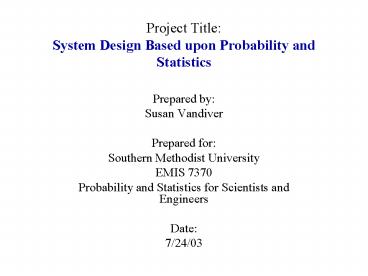Project Title: System Design Based upon Probability and Statistics - PowerPoint PPT Presentation
1 / 19
Title:
Project Title: System Design Based upon Probability and Statistics
Description:
The objective of this project is to determine some valuable methods of utilizing ... this report will only have a cursory view of the subject which probably could ... – PowerPoint PPT presentation
Number of Views:35
Avg rating:3.0/5.0
Title: Project Title: System Design Based upon Probability and Statistics
1
Project TitleSystem Design Based upon
Probability and Statistics
- Prepared by
- Susan Vandiver
- Prepared for
- Southern Methodist University
- EMIS 7370
- Probability and Statistics for Scientists and
Engineers - Date
- 7/24/03
2
- Project Overview
- Objective
- The objective of this project is to determine
some valuable methods of utilizing probability
and statistics in the system design process. - Description
- Study the system engineering design sample space
- Draw Venn Diagrams of the sample space
- Apply the decision tree diagram process to system
design - Determine some of the critical metrics that are
important to successful system design - Look for any new application of other probability
and statistic models in the system design process
3
- Overview (continued)
- Approach
- Develop new and investigate existing application
of probability and statistics to system
engineering design - Resources include
- Information from previous classes
- System Integration and Test
- System Design
- System Reliability
- Risk Management
- Additional resources include the internet,
books and magazine articles. - Plan
- Due to limitations in the time available, this
report will only have a cursory view of the
subject which probably could be contained in a
book.
4
- Introduction
- The goal in system design is to achieve a
product that is a 100 success. - The application of probability and statistics to
system design assists in converting an
unpredictable outcome to one that is both
predictable and positive. - The portfolio of tools and best practices
utilizing probability and statistical methods for
system design is extensive and increasing.
5
- Results
- Defining the design space
Done before, what are the known issues
Soln 3
Soln 1
New technology, opportunity for improvement
or disaster.
Soln N
Soln 2
System design starting point Soln 1 n Soln 2 n
Soln 3 n ... n Soln N
6
- Requirements design space
System scenarios
General Requirements
Safe
Producible
Quality
Maintainable
Reliable
Cost effective
Works in the environment
Usable
Optimal/Robust
Specific Requirements
7
- Risk is the probability that a future unwanted
event will occur. The severity of the risk is
the consequences of the event occurring. - Known solutions New solutions
Issues
Full of risk
Risk
8
- Robust systems
System boundary conditions
a system parameter
B
Robust vs. optimal
A
9
- Example of variation of parameters due to
manufacturers specific process - Sorting
- No sorting
- Sorting by tolerance
- Sorting by value
- (The following examples use a Monte Carlo
simulation - to generate the data for manufacturing a 1000 ohm
- resistor with a normal distribution. The value
for - Z is 1.65 for 95 of the population giving
s30.3.)
10
Sorting by tolerance
11
(No Transcript)
12
Sorting by value
13
- Strength of materials (stress, strain, and
fatigue life) are important parameters in system
design. - As shown on the next page, the values are
statistical. Engineers cannot simply read a value
from the graph and use this value in calculations
without understanding the variances.
14
14
15
- Tools and Best Practices
- Statistical experiment design
- Taguchi methods
- Sensitivity analysis/utility curves
- Quality function deployment
- Houses of quality
- Critical parameter management
- Basic statistical techniques
- Descriptive statistics
- Distribution parameters (normal, exponential,
Weibull, etc) - Graphical techniques
- Box plots Histograms
- Scatter plots Time series plots
- Run charts Pareto charts
- Inferential statistics Central limit theorem
- Hypothesis testing Confidence intervals
- Sample size determination
16
- Reliability is the probability that an item can
perform its intended function for a specified
interval under stated conditions. - MTBF Redundancy
- Reliability prediction Monte Carlo simulation
- Probability distribution
- Maintainability is the probability that an item
will be retained in or restored to a specified
condition within a given period of time. - MTTR FMECA
- Probability distribution Maintenance downtime
- System availability Spares allocation
- Systems engineering should consider normal and
out-of-normal environmental conditions. - EMI/EMC/ESD Shock
- Vibration/acceleration Humidity/rain/ice
- Altitude Salt spray
- DFSS is an plan for quality over the products
life cycle.
17
- Example of a Decision Tree Diagram at a High
System Level - (reference Wiley Series in Probability and
Statistics)
Option1
Perform Tradeoff Analysis/ Select Best Soln
Not Agreed
Optimized by decisions
Option N
Value
Rqmts
Empty Risk Cup
ID Issues
Design Agreed To
New Tech
Empty Risk Cup
Feasible?
Can we do it?
Does it have advantages?
ID Risk
Too much risk
No
No
No
18
- Summary
- We have briefly touched the surface of the many,
many applications of probability and statistics
to system design.
19
- Conclusions
- Design has always been considered an inventive
process, whereas using probability and statistics
to perform system design transforms it into a
technical process. - There is no one book that could be located on
this subject however, there is extensive
information that can be culled from multiple
sources. - It can be concluded that using probability and
statistical based system design contributes
greatly to accomplishing the goal of achieving a
product that is a 100 success.































